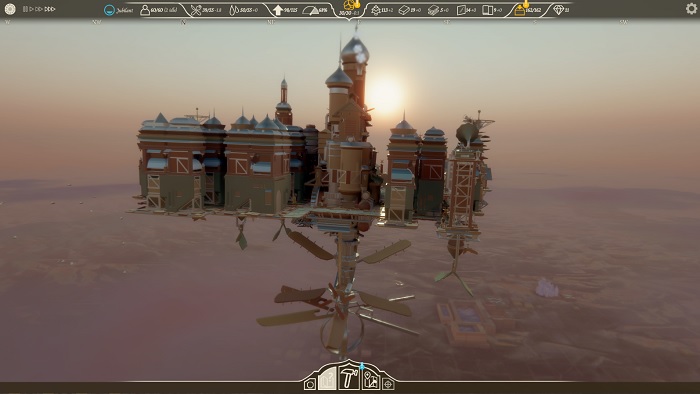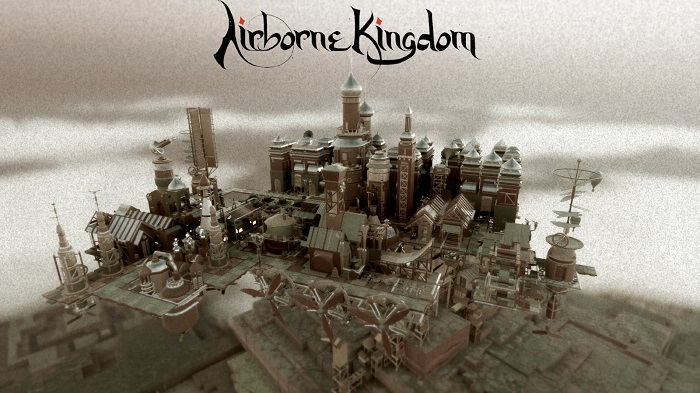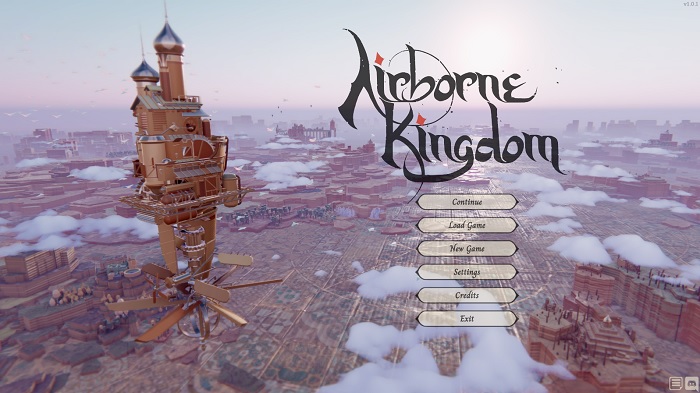Subjective:
The Wandering Band, acting as both director and publisher, presents the gravity-defying city simulator Airborne Kingdom. The player, taking control of a newly skybound village hub, will seek to unite 12 kingdoms under an ancient prophecy. Airborne Kingdom seeks to transform the typical city builder by requiring the player to consider the limitations of space, additional weight, and scarce resources on a teetering realm.
Objective:
The basics of Airborne Kingdom call for the player to move the flying land where it needs to go for resources. Standard consumables, like food and water, join piecemeal construction items gathered from cotton and quartz to be refined into advanced materials. The only challenge to gathering is ensuring at least one citizen is available as gathering happens via planes collecting and depositing their payload from stationary hubs. As materials are gathered and new citizens moved in, the player may construct an array of homes, crafting centers, research hubs, and other various facilities to make life better for the flying folks.
As the player makes life more comfortable for their citizens, they may reach out to the land-bound kingdoms to forge a longer-lasting union. This takes the form of quests which send the flying kingdom out into new lands to search for obscure items, locating lost peoples, or loaning out some of the flying resources to aid in ground construction. Each unification quest provides a handful of new citizens on top of the items which may be purchased for later research into new kingdom components.

Assessment:
City simulators work on two primary levels. The first is as an unfolding diorama where the player’s choices allow for a creation in a (hopefully) unique environment. The second is where those choices have an effect on the city which changes the mechanics of survival or needs of its digital denizens. As a stylized diorama, Airborne Kingdom is tops, but those wanting the slightest bit of meat with the style are going to be disappointed.
Yet, oh my, the handful of hours I spent in wonder at Airborne Kingdom‘s splendor. The land spools out like a high-quality board game and the citizens have a teeny extra bounce in their step for their jobs even if they’re faceless. Additionally, right up until I had to stop to write this – I was still finding little details that tickled me in the design of the kingdom. My new favorite was, upon inspecting a shrine in close-up, I saw that it was a colossal glowing music box with perpetually rotating spines as its walls. A built-in camera mode allows for a superb level of visual manipulation so the player may make their city look like an elaborate LEGO or gritty B-reel of Metropolis.

This does tie into one aspect of Airborne Kingdom that many city simulations lack – a story mode. The gradual unfolding of interconnected flying parts slots well alongside the kingdom’s prophesied role in unifying the lands below. This rarely amounts to more than looking for lost explorers or the remnants of a treasured relic, but the low stakes of the quests fit in with the relaxed vibe of Airborne Kingdom. The world will continue to roll on if you fail, it’ll just be that much more connected if you succeed.
The trouble starts to roll in after a few hours of play and I realized that the nonthreatening vibe of the quests extends to the shallow gameplay. Even with advanced buildings that generated food and specialty items, the gameplay never evolved beyond moving my kingdom into position for numbers to go up. Management is largely nonexistent as any building with a negative effect has the same negative effect (don’t move citizens close) and there’s little synergy between one structure making the numbers of the other go up.

Even the necessity of keeping the kingdom balanced is a largely trivial task which primarily affects travel. The switch is in finding placement for a building which makes numbers go down instead and get the kingdom as close to 0 degree in/decline as possible. If you don’t mind asynchronous looks to your city, solving a slanted town is as easy as building a road all on its lonesome then sticking a fan on the end. Since there’s nothing to keep track of, like citizen exhaustion or even wind resistance on your city, then the main mechanic of Airborne Kingdom becomes something that barely needs to be addressed. When there is something to keep track of it falls under busywork, like needing the one currency which doesn’t require storage or weight on your kingdom to purchase blueprints for the ability to research new additions.
Airborne Kingdom was reviewed using a reviewer-purchased copy of the game on the PC through the Epic Game Store.
The Review
Airborne Kingdom
Airborne Kingdom presents the case where its presentation and charm are first-rate but attached to systems which require little care. The lack of conflict, while refreshing, also means no kingdom has needs much different from the rest. As a result, Airborne Kingdom is - at the risk of arriving at a cheeky conclusion - weightless as an overall experience. If the systems are ever beefed up or complexity added to life aboard the flying land then this will be worth revisiting. As it stands, I'm still grateful for those cheery moments of discovery before the boredom steadily crept in.
PROS
- Gorgeous tactile aesthetic makes Airborne Kingdom the best looking board game not yet made.
- The rare city builder story mode provides a refreshing journey of unification.
CONS
- Central mechanic only matters for the aesthetically obsessed and rarely requires thoughtful construction.
- Without more needs or systems requiring attention and balance, the world fades into one gorgeous grid after another.



